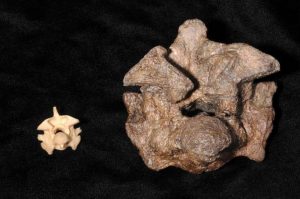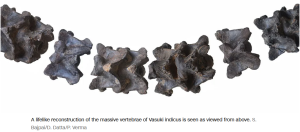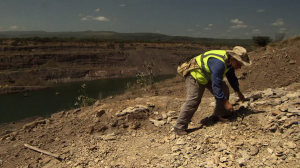Podcast: Play in new window | Download (Duration: 17:49 — 20.3MB)
Subscribe: | More
Thanks to Max and Pranav for their suggestions this week! We’re going to learn about some crocodylomorphs and a few other ancient non-dinosaur reptiles.
Further reading:
Mammal-like crocodile fossil found in East Africa, scientists report
Ancient crocodiles walked on two legs like dinosaurs
Fossil Footprints Help Uncover the Mysteries of Bipedal Crocodiles
Fossil mystery solved: super-long-necked reptiles lived in the ocean, not on land
Kaprosuchus had TEETH:
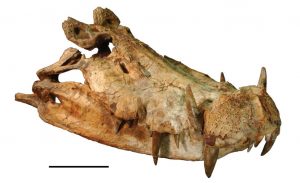
Anatosuchus earned its name “duck crocodile”:
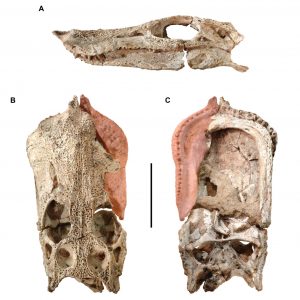
Ancient bipedal croc footprints (picture taken from link above):
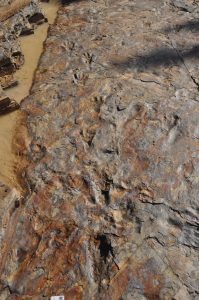
Tanystropheus had a super long neck:
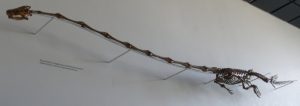
Show transcript:
Welcome to Strange Animals Podcast. I’m your host, Kate Shaw.
This week we’re going back in time to learn about some prehistoric reptiles that aren’t dinosaurs. Most are crocodylomorphs, which Pranav suggested a while back, but not all. Thanks to Pranav and Max for their suggestions this week! Max even made some clay models of two of these animals and sent me pictures, which was amazing! I have some really talented listeners.
Pranav and Max both wanted to know about kaprosuchus, also called the boar crocodile. The boar croc lived around 95 million years ago and probably grew nearly 20 feet long, or 6 meters, although all we know about it right now comes from a single nearly complete fossilized skull. The skull was found in Niger, a country in West Africa, and only described in 2009.
The boar croc gets its name from its teeth. It had lots of teeth, because it was a crocodyliform, although not actually an ancestral crocodile. It was related to modern crocs, though. Three sets of its teeth were especially long and large and projected out of its mouth much farther than ever found in any croc or croc relative, with one pair of teeth so big the upper jaw had little grooves for them to fit into so it could actually close its mouth. The teeth look like boar tusks, especially warthog tusks.
The boar croc also had some other differences from other croc relatives. The tip of its snout is unusually heavy, and some researchers think it might have had a keratin sheath over it. It might have used its heavy snout as a battering ram, possibly to stun prey before grabbing it with its huge teeth. It most likely hunted on land instead of in the water, since its eyes were lower on its head than crocs that hunt in water. Modern crocodiles and their relations mostly have eyes at the top of the head, which allows them to stay submerged except for their eyes. Whether it hunted in water or on land, though, the boar croc definitely killed and ate small dinosaurs, or maybe not so small dinosaurs.
The boar croc also had some horn-like projections on the back of its head. I don’t want to alarm you, because this animal went extinct millions and millions of years ago, but this thing was basically a dragon.
Anatosuchus was another crocodylomorph whose fossils have been found in Niger, but it’s much smaller and weirder than you’d expect. It was a tiny little thing, estimated to grow only a little more than 2 feet long, or 70 cm, and it was lightly built with relatively long legs for a croc relation, although it was still smaller than a cat. Its small teeth curve backwards but its snout has a little pointy projection at the front, although its head is broad and flat so that from above, its snout looks kind of like a duck’s bill. That’s why it’s sometimes called the duck crocodile. It lived around 145 million to 100 million years ago. Researchers think it may have waded in shallow water to catch small animals like fish and frogs, something like a heron.
Around 105 million years ago, another small croc relation lived in what is now Tanzania in East Africa. It was first discovered in 2008 and has been named Pakasuchus, which means cat crocodile. It was even smaller than the duck crocodile, only 20 inches long, or 50 cm, with long legs and a delicate build. The really weird thing, though, is its teeth. Unlike other crocodile relations and in fact unlike reptiles in general, it had teeth that were specialized for different functions. Its teeth looked like they belonged to a mammal. It had sharp teeth at the front of its short jaws and broader teeth in the back of its mouth that it used to chew its food. It was a terrestrial animal that would have been active and fast-moving. It probably ate insects and other small animals, but some researchers think it may have eaten plants.
There were definitely some croc relatives that were herbivorous, like the aetosaurs. Aetosaurs lived a little over 200 million years ago and were a successful group, with fossils found in Europe, India, Africa, and North and South America. They had osteoderms that are really common in the fossil record, so common that they’re used as index fossils to date fossil sites. If you’re not sure how old a layer of rock is, and you find some aetosaur osteoderms, you can be pretty certain you’re looking at the late Triassic. The osteoderms are flattened like big scales, and in fact when they were first discovered, people thought they were actually fish scales. Aetosaurs were probably terrestrial animals and most were either herbivorous or omnivorous, although at least one known species had the kind of teeth that indicate it hunted small animals.
A typical aetosaur had a small head and a bulky body with relatively small front legs but stronger hind legs. Its tail was long and tapering like a modern crocodile’s tail. It had lots of armor in the form of interlocking osteoderms, including armor on its belly and the underside of its tail. It might have looked like it had a carapace something like a weird reptilian armadillo. Depending on its species, our typical aetosaur may have also had spikes or spines on its back sort of like modern crocodiles have.
One species of aetosaur, Desmatosuchus spurensis, had massive shoulder spikes. Desmatosuchus grew almost 15 feet long, or 4.5 meters, and was heavily armored, with a spike on each shoulder blade. The spikes curved up and out kind of like a bull’s horns, but instead of pointing forward, they pointed backwards. It also had smaller spikes down its sides, some of which pointed out, some up. The big shoulder spikes could be almost a foot long, or 28 cm.
If you look at Desmatosuchus’s skeleton, it looked like it must have been a dangerous animal, and this would have been true when it comes to worms and plants. Its head was small and ended in a shovel-like snout, probably covered in a keratin sheath like a turtle’s beak. Scientists think it probably used its snout to dig plants up from soft mud along waterways, and it would probably also eat any small animals it found in the mud too. It lived in groups and despite its size and all its spikes, it got eaten a lot by an even bigger reptile, Postosuchus.
Postosuchus wasn’t a dinosaur, and was in fact a crocodylomorph just like the other reptiles we’ve talked about so far, but it sure looked like a dinosaur in a lot of ways. Its front legs were about half the length of and not very strong compared to its hind legs, so it probably walked on its hind legs only. It also had an oversized claw on one of its toes that it probably used to slash at prey, while its big head had a mouth full of big, sharp teeth. In other words, it looked a lot like a theropod dinosaur and lived at about the same time as the first theropods.
Despite not being a dinosaur, Postosuchus was one of the biggest land animals around, growing up to about 23 feet long, or 7 meters, although it probably only stood about 4 feet high, or 1.2 meters. Its remains have only been found in North America.
Other bipedal croc relations have been found in Asia, though, specifically in South Korea where almost 100 beautifully preserved footprints have been found. The tracks are of hind feet only, and from their size, depth, and the length of stride, the animals were probably almost 10 feet long, or 3 meters, and had hind legs the length of an average adult human’s legs. The footprints are almost 9 ½ inches long, or 24 cm.
At first researchers thought the tracks belonged to giant pterosaurs, which were flying reptiles, and that the pterosaurs were walking on their hind legs so their wings would stay out of the mud. But the footprints are so well preserved that it was obvious they belonged to a crocodylomorph once paleontologists examined them closely. In fact, all footprints supposed to belong to pterosaurs walking on their hind legs have turned out to belong to bipedal croc relations. Pterosaurs had to use their wings as front legs when walking on the ground, like bats do but not like birds, and some crocs, which ordinarily walk on four legs, were walking on two. It’s topsy-turvy land!
The tracks in South Korea are dated to a little over 113 million years ago, which is something like 100 million years more recent than Postosuchus. Postosuchus went extinct around 201 million years ago, at the end of the Triassic. By the time the Korean croc relation was walking around, it was the middle of the Cretaceous and dinosaurs ruled the earth. Gondwana was breaking up, the climate was warm worldwide and sea levels were high, mammals were tiny and unimportant, and little birds were flying around along with gigantic pterosaurs like Quetzalcoatlus. Crocodile relations lived in the mid-Cretaceous, sure, but not bipedal ones…or so paleontologists thought.
All we have of these croc relations are their tracks. We don’t have any fossils so we don’t know what they looked like. Hopefully one day some fossils will come to light and paleontologists will be able to match them up with their footprints.
Max specifically asked about Titanoboa, a gigantic extinct snake that lived around 58 million years ago in what is now northern South America. We talked about Titanoboa in episode 197 but I was certain I could find some new information for this episode. Unfortunately, there haven’t been any new studies about Titanoboa published recently, so Max, I’m going to keep it on the suggestions list until I find some interesting new information to share.
Titanoboa is estimated to have grown as much as 42 feet long, or 13 meters, and it probably spent most of its time in the water, eating giant lungfish and other animals. But, to wrap things back around to crocodylomorphs, it probably also ate a croc relation called Cerrejonisuchus. Cerrejonisuchus had a short, narrow snout and probably ate lots of frogs, fish, and other small animals. It grew a little over 7 feet long, or 2.2 meters, which is small but respectable for a crocodile but nowhere near big enough to make Titanoboa think twice about eating it. It wasn’t even the biggest croc relation living in its river habitat. Acherontisuchus grew to an estimated 21 feet long, or almost 6.5 meters. It had a long snout and lots and lots of big teeth, and probably ate the same fish that Titanoboa also liked.
Let’s finish with a non-crocodylomorph ancient reptile, Tanystropheus, and two mysteries associated with it that science solved in 2020. Tanystropheus lived during the mid to late Triassic, around 240 million years ago, and its fossils have been found in parts of Europe, the Middle East, and in China. It grew up to 20 feet long, or 6 meters, but literally half its length was its incredibly long neck.
When the first Tanystropheus fossils were discovered in the 19th century, paleontologists didn’t know what it was. There were some long, thin bones associated with the skeleton and they thought those might be elongated finger bones. Tanystropheus was classified as a type of pterosaur. But as more and better fossils were discovered, it was obvious that this animal wasn’t flying anywhere. The finger bones were actually cervical ribs, rod-like structures that helped stabilize the long neck and keep it from bending very far.
Tanystropheus was reclassified as a long-necked reptile, but no one was sure if it lived in water or just around water. Even more confusing, fossils of smaller long-necked reptiles, only about 4 feet long, or 1.2 meters, started being found too. No one was sure if this was a different species or juvenile Tanystropheus specimens.
To solve the first mystery, a research team took CT scans of some complete but crushed Tanystropheus skulls and generated a 3D image, which allowed them to put the pieces together and examine an image of a complete, un-crushed skull.
The skull had nostrils at the top of its snout, indicating that it probably spent a lot of time in the water. Some researchers suggest it was an ambush predator in shallow water, resting on the bottom of the ocean with its long neck raised so its nostrils were just above the surface. When a fish or other animal swam by, it could grab it without needing to move more than its head. Since its body was chonky with short legs, it probably wasn’t a very fast mover.
Next, the team took cross sections of bones from the smaller long-necked reptile and examined them for growth rings. They found a lot of them, indicating that the animals weren’t juvenile Tanystropheus hydroides, they were adults of another species, which has been named Tanystropheus longobardicus. The two species also had differently shaped teeth, which suggests that they were eating different types of food.
Even though Tanystropheus’s neck was really long, it was also much lighter than the rear half of its body, which had strongly muscled hind legs. Some researchers think it swam by kicking its hind legs sort of like a gigantic frog’s. We have some fossilized trackways from a shallow marine environment that show paired prints from hind legs, but no front leg prints, which may be from a small species of Tanystropheus.
There’s still a lot we don’t know about Tanystropheus, just as there’s a lot we don’t know about a lot of long-extinct animals. All we know for sure is that they were awesome.
You can find Strange Animals Podcast at strangeanimalspodcast.blubrry.net. That’s blueberry without any E’s. If you have questions, comments, or suggestions for future episodes, email us at strangeanimalspodcast@gmail.com. If you like the podcast and want to help us out, leave us a rating and review on Apple Podcasts or Podchaser, or just tell a friend. We also have a Patreon at patreon.com/strangeanimalspodcast if you’d like to support us for as little as one dollar a month and get monthly bonus episodes. There are links in the show notes to join our mailing list and to our merch store.
Thanks for listening!
